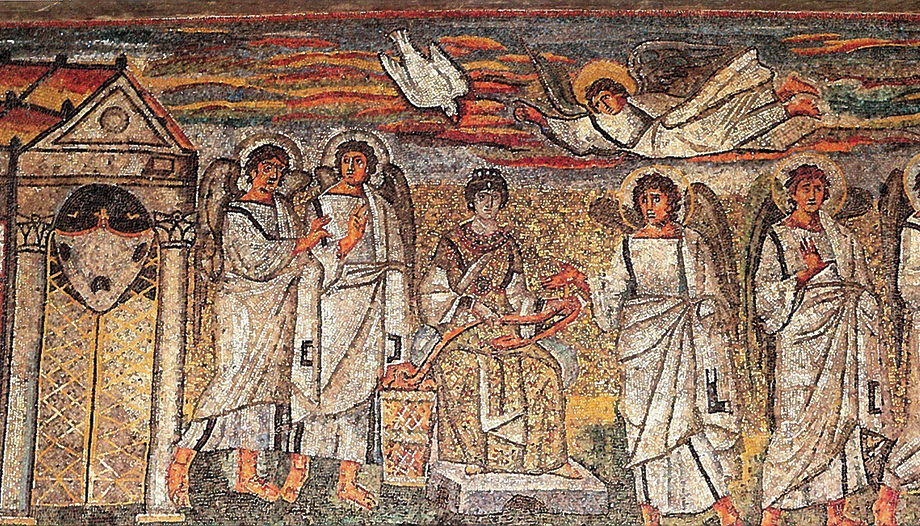Nine months before the feast of the Nativity of the Lord, the Church celebrates the feast of the Annunciation to Mary. Artists of all times have represented it. Its main iconographic source is the Gospel account of St. Luke (1:26-38). The most ancient representations are in the catacombs of Rome; for example, in the painting on the vault of a cubiculum from the catacombs of Priscilla, from the 3rd century. Since the 5th century, we also find this motif in the interior of churches.
In the Roman basilica of St. Mary Major (432-440), the Annunciation is the first scene on the left in the triumphal arch. Mary is depicted as a Queen. Attired in a golden imperial dress, she is seated on a throne. At her sides she is solemnly attended by three angels in white robes. Her hair is adorned with precious pearls, and her feet are resting on a suppedaneum. These ceremonial-courtesan details are explained by the decision of the Council of Ephesus (431) to define her as the Mother of God (Theotokos).
Dialogue between Mary and Gabriel
The scene of the birth of Christ does not appear in the triumphal arch of the basilica. It must therefore be assumed that the Annunciation here includes the Incarnation. Above the clouds of heaven, the fourth angel announces the conception to Mary. In addition, a white dove can be seen as a symbol of the Holy Spirit.
Mary prepares a purple cloth for the veil of the temple, which is depicted on the left in synthetic form. The motif of weaving the purple veil can be traced back to legendary additions to the Protoevangelium of St. James (PsJac 11, 1-3), from the second century. A later source is the Gospel of pseudo-Matthew (PsMt 9), from the IX century. In popular piety and iconography the motif was very widespread, also up to the late Middle Ages, because the Legenda aurea (ca. 1264) by Jacobus de Voragine, which was widely read, received these two apocryphal texts.
Especially in Byzantine art the motif of the purple fabric was widespread. In the ivory relief of the Annunciation on the chair of Archbishop Maximian (between 546 and 556 in Ravenna, Archbishop's Museum) Mary appears seated on a high-backed throne. Her left hand grasps a purple spindle. Her right hand points to the Archangel Gabriel, who announces the good news to her. Like angelosGabriel usually carries a messenger's staff. In Ravenna, a staff of command distinguishes him as "Prince of the heavenly militia" (Archistrategos). Mary's head is covered with the virgin veil (Maphorion).
In the Middle Ages, artists depicted the dialogue between Mary and Gabriel in most cases with both figures standing, emphasizing hand gestures and gazes. Also in the illumination of books and manuscripts, the compositions preferred standing figures. The Gospels of Otto III (ca. 1000, Aachen, Cathedral Treasury Chamber) shows the Annunciation in a solemn and monumental style (fol. 125r). The hand of God the Father, on high, in a round image, indicates the supernatural action during the Incarnation of the Son. The aforementioned type, with the standing figures, continued in the sculpture of the portals of Gothic cathedrals, as in Chartres, Reims, Amiens, Strasbourg, Bamberg, Freiburg and Cologne.
The Holy Spirit, the efficient principle of the Incarnation, used to be represented in a symbolic way as a dove along a ray of light, as in the painting by Carlo Crivelli (1486, London, National Gallery) or just above Mary's face, as in 1480-1489 in Hans Memling's painting (New York, The Metropolitan Museum of Art).
Narrative realism
In the 15th century a type of Annunciation emerged in which the Infant Jesus appears fully formed. The Antependium of the high altar of the cathedral of Teramo (1433-1448, Nicola da Guardiagrele) presents Jesus as a bambino in the hands of the angel, who offers him to Mary. On the other hand, in the relief of the tympanum of the chapel of the Virgin of Würzburg (1430-1440), Jesus descends upside down through the lightning. With the appearance of a hose, this ray of light goes from the mouth of God the Father to Mary's ear, where the Holy Spirit blows the good news into her ear (conceptio per aurem). In the central table of the Mérode Triptych (1425-1435), by Robert Campin (New York, Metropolitan Museum of Art), the Child Jesus appears with a small cross on his shoulders.
What significance can this small figure of Christ arriving "flying" to Mary have? At first glance there seems to be a conflict here with dogmatic tradition. In the Creed, the Church prays even today: "...by the power of the Holy Spirit he became incarnate of Mary, the Virgin." (et incarnatus est de Spiritu Sancto ex Maria Virgine). A review of Byzantine and medieval Western iconography shows that the mentioned pictures are not to be considered "heretical" at all. With the help of the example of "Mary's falling asleep" (koimesis, dormitio) it is clear that the human soul was represented in the artistic tradition of the time as a small figure. In the representations of the Annunciation, the "Child" thus symbolizes the soul created by God, while the body of Jesus comes only from Mary.
The place of the Annunciation was represented since the 15th century as a concrete space. In Italy, in 1452-1466 Piero della Francesca placed the scene in a palace (Arezzo, San Francesco) and Fra Angelico in 1430-1432 in a portico (Madrid, Prado). Both also emphasize the majesty and humility of Mary. The early Flemish preferred the interior of a church, as Jan van Eyck in 1434-1436 (Washington, National Gallery of Art) or the contemporary bourgeois interior, such as Rogier van der Weyden around 1455 in the Triptych of the altar of St. Columba, Cologne (Munich, Alte Pinakothek). The narrative realism of these paintings sought to attract the attention of observers.







